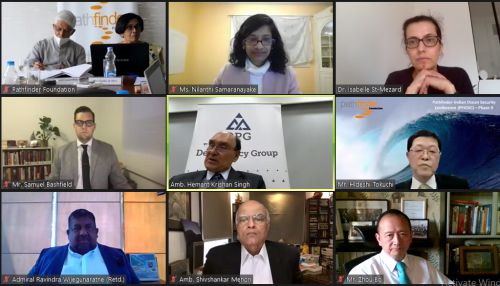Remarks by Ambassador H.K. Singh at Pathfinder Indian Ocean Security Conference - Phase II
PATHFINDER INDIAN OCEAN SECURITY CONFERENCE
(PFIOSC) PHASE-II
March 4, 2022
(Virtual Conference)
I. OPENING REMARKS
Ambassador Bernard Goonetilleke and
Ambassador Shivshankar Menon, Co-Chairs of this Conference,
Ambassador Geetha de Silva, Secretary General,
Distinguished Presenters, Panellists and Participants,
It is my great pleasure to join the “Pathfinder Indian Ocean Security Conference – Phase II” and to moderate this first session on “A New Security Architecture for the Indian Ocean Region”.
I would like to congratulate Ms. Nilanthi Samaranayake for her impressive paper on “Prospects for New Security Architecture for the Indian Ocean Aimed at a Rules-Based International Order, Consistent with the Free and Open Indo-Pacific Strategy.”
Allow me to make some general observations on the theme of this session.
The sheer diversity among nations of the Indian Ocean rim is quite staggering, and capacity limitations faced by most make cooperative endeavours inevitable.
At the same time, this diversity is balanced by a shared history of the region which has been closely interconnected by trading and cultural links from times of antiquity. There is also a common desire to avoid repeating the colonial experience, and the realisation that unless regional nations take responsibility for their own security, external powers will return to exploit them.
Thus, there is today greater understanding that security foundations must be determined primarily by regional nations, with due regard for extra-regional stake holder interests, as for instance evidenced in the Jakarta Concord of IORA.
Meanwhile, globalisation and the economic rise of Asia have transformed the Indian Ocean from the strategic backwater it was during the Cold War to among the busiest connectors of global commerce today. Energy, mineral resources and manufactured good transit the Indian Ocean, connecting the thriving economies of Asia with the wider world. Global power rebalancing towards Asia is moving it to the world’s geopolitical centre stage, but is also giving rise to great power competition.
The increased usage of the Indian Ocean has led to the growth of multiple humanitarian and governance challenges. Extra-regional presence in the Indian Ocean has also increased substantially, adding to security concerns. There are, at any stage, upwards of 100 extra-regional warships present in the Indian Ocean.
As geopolitical competition intensifies, IOR nations will face increased pressure. The subject of this session is, therefore, of vital interest to all.
Some signs of an Indian Ocean community are emerging. Several regional and sub-regional architectures have evolved, such as IORA and IONS but also others.
However, the process of community building still remains very much a work in progress.
In this session, we will examine whether the Indian Ocean’s existing security structures are sufficient to address challenges of our times, or we need to envisage a new architecture.
Our paper presenter is Ms. Nilanthi Samaranayake from the Centre for Naval Analysis in Washington D.C. Our panellists are Dr. Isabelle Saint-Mezard from the French Institute of Geopolitics, Paris and Mr. Tokuti Hideshi, President of the Research Institute of Peace and Security, Tokyo. They all come with very impressive CVs, which are already available on the event website.
Without further ado, let me now invite Ms. Samaranayake to present her paper. You have the floor for 15 minutes.
II. QUESTIONS FOR PANELLISTS
I would like to thank Ms. Samaranayake for her clear and cogent presentation. Let me raise a few pointers for our panellists.
Under Miles’ Law, “Where you stand depends on where you sit.” So, for the panellists who are both from extra-regional nations, do you sit in the same place as the presenter?
How do we reconcile the gap between the needs of nations for autonomy and regional needs for effective security?
Is international law by itself sufficient to provide security, without the mechanisms to sustain rules-based order?
Is there any traction today for concepts such as IOZOP which date back 50 years?
Are regional architectures focused only on setting norms workable in an era of revived great power contestation?
Have multilateral solutions expanded South East Asia’s autonomy or security, or regional stability?
Ms. Samaranayake has elaborated three models based on “status quo”, “regional leader” and “small States”, concluding that the status quo model might most benefit Indian Ocean countries. Do you agree with her? If not, do you have an alternative model to suggest?
I now invite Dr. Isabelle Saint-Mezard to make her remarks.
I now invite Mr. Tokuti Hideshi to make his remarks.
III. CONCLUDING REMARKS
This has been a rich discussion, and in summing up, I would like to make a few observations.
It is also clear that in this anarchic world, some nations honour their treaty and international law commitments, and others do not.
In addition to discussing the mechanics of a new security architecture, it is perhaps appropriate and necessary to also discuss guiding regional visions, such as the FOIP of the Quad, ASEAN’s AOIP and India’s SAGAR and IPOI.
At a time of increasing great power contestation, any security architecture will have to balance the interests of regional nations with the needs of great powers, from the region or beyond.
It is useful here to bear in mind that India is not a distant great power, it is an IOR resident with a complete vision for the Indian Ocean in the form of SAGAR. This only amplifies the need for discussion of the multiple visions which are extant.
In conclusion, I would largely agree with Ms. Samaranayake that her status quo model holds some promise, along with the caveat that given the indivisible nature of the seas, it will not be possible to maintain the Indian Ocean as a distinct theatre from the Pacific.
What we must aspire to is a free, open, inclusive and cooperative security architecture aligned with UNCLOS and buttressed by a shared vision of a prosperous Indian Ocean community of nations. That is now a task for future iterations of this conference.
====




